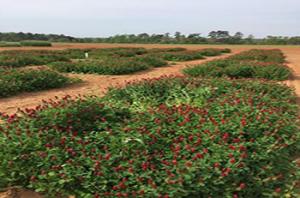Cover Crop Performance and Adaptation Trials at PMCs

Farmers rely on the latest crop variety trials to make informed decisions on planting the best adapted crop variety to maximize yield given their soils and production practices. With the ever-growing interest in planting cover crops, the NRCS Plant Materials Centers initiated studies to better characterize performance and adaptation of commercially available cover crop varieties. Choosing the most appropriate cover crop varieties, like choosing the best crop varieties, will ultimately assist farmers to better meet the objectives of their production systems.
When a cover crop species is chosen to meet a resource concern, a variety from that species may be selected to meet needs such as: 1) production of early or late cover, 2) early or late maturity, or 3) winter survival. By choosing varieties based on the production system, cover crop plans and systems can be developed to:
- time planting and termination dates to fit within the cropping system,
- develop mixes with species that mature at similar times to facilitate mechanical termination,
- use winterkill as a method of termination,
- use moderate levels of winterkill to manage competition of aggressive species, and
- use maturity dates to regulate the amount of cover crop residue.
The information below includes reports and technical information related to the performance and adaptation of cover crops in different part of the Unites States.
National Cool Season Cover Crop Adaptation Trials
Spring planted cool season cover crops in the Northern Great Plains
Other Cool Season Cover Crop Trials
Warm Season Cover Crop Adaptation Trials
National Cool Season Cover Crop Adaptation Trials
Plant Materials Centers (PMCs) at over 20 locations conducted a 2-year evaluation of nearly 60 commercially available varieties of balansa clover, black oats, black seeded oats, cereal rye, hairy vetch, crimson clover, oilseed and daikon radishes, red clover, and winter/field peas to assess their adaptation and performance as cover crops across the United States.
National Trials - Regional Cover Crop Technical Notes
The technical notes summarize data collected by PMCs in each region of the U.S. for the 2016-2017 and 2017-2018 winter cover crop seasons and in selected locations for 2017 and 2018 spring-seeded cover crop seasons. Information is provided in a table format that allows conservation planners and producers to determine the performance and potential adaptation of a cover crop for each area at a glance. These reports include information for all cover crops except for balansa clover which had high variability of establishment among locations.
Northeast– PDF file, 1.5 MB
Southeast – PDF file, 950 KB
North Central – PDF file, 1.2 MB
South Central – PDF file, 1.2 MB
Northwest– PDF file, 1.4 MB
Southwest – PDF file, 1.5 MB
Spring-seeded cover crops in CO, MT and ND - PDF file, 1.1 MB
Supporting Data and Analysis – PDF file, 6.1 MB
National Trials - Plant Materials Center Study Reports
Each Plant Materials Center report includes detailed information on the results of all cover crops in this study, including balansa clover. Some reports may include three years of data as well as biomass measurements for the different varieties.
AZ-Tucson – PDF file, 263 KB
AR-Booneville – PDF file, 244 KB
CA-Lockeford – PDF file, 639 KB
FL-Florida – PDF file, 632 KB
GA-Americus – PDF file, 292 KB
ID-Aberdeen – PDF file, 739 KB
KS-Manhattan – PDF file, 268 KB
MD-Beltsville – PDF file, 436 KB
MS-Coffeeville – PDF file, 486 KB
MO-Elsberry - PDF file, 190 KB
NV-Fallon – PDF file, 938 KB
OR-Corvallis – PDF file, 572 KB
TX-Knox City – PDF file, 211 KB
TX-Nacogdoches – PDF file, 356 KB
WA-Pullman – PDF file, 559 KB
Spring planted cool season cover crops in the Northern Great Plains
Some areas of the country are challenged with fall sown cover crops due to late harvest and early frost. These locations followed a similar protocol to the national trial but sowed the cover crop seed in the spring instead of the fall.
MT-Bridger – PDF file, 856 KB (spring planted)
ND-Bismarck – PDF file, 201 KB (spring planted)
Other Cool Season Cover Crop Trials
California: Technical Note, Adaptation of Cover Crop Cultivars to California's Central Valley (PDF; 749 KB)
Montana: Technical Note, Evaluation of Cool Season Cover Crop Species in Southern Montana (PDF; 494 KB)
Texas (western): Winter Cover Crop Species Adapted to North-Central West Texas and Southwestern Oklahoma (PDF; 276 KB)
Warm Season Cover Crop Adaptation Trials
California: Adaptation of lentil cultivars as cover crops in California's Central Valley (PDF; 2.7 MB)
California: Adaptation of warm Season Cover Crops for California (PDF; 875 KB)
California: Evaluation of Drought Tolerant Cover Crops for California's Central Valley (PDF; 665 KB)
Florida: Evaluation of Warm-Season Grasses for Use as Cover Crops in Florida (PDF; 1.1 MB)
Florida: Performance of Warm-Season Legume Cover Crops in Florida (PDF; 1.1 MB)
Georgia: Evaluation of Warm-Season Cover Crops on the Southern Coastal Plain (PDF; 497 KB)
Idaho: One Year Evaluation of Warm Season Cover Crops in the Intermountain West (PDF; 447KB)
Louisiana: Warm Season Cover Crop Adaptation Study Trials Using Crotalaria Entries for Southern Louisiana (PDF; 250 KB)
New Jersey: Millet Adaptation Trial in Coastal Plain Sandy Loam Following Fall-Seeded Cover Crops in Southern NJ (PDF; 790 KB)
Oregon: Irrigated Warm Season Cover Crops for Western Oregon (PDF; 5.5 MB)
Texas (western): Summer Cover Crop Species Adapted to North-Central West Texas and Southwestern Oklahoma (PDF; 265 KB)
Texas (western): Technical Note: Summer Cover Crop Species Adapted to North-Central West Texas and Southwestern Oklahoma (PDF; 2.9 MB)

